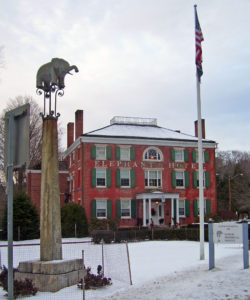We often talk about the elephant in the room—or not talk about it, as the saying goes. But what about the elephant in the country, the first one in the country?
It had to happen sometime, and that time was April 13, 1796. America’s first elephant arrived from Asia, aboard the merchant ship America! She was a two-year old female. The ship’s captain, Jacob Crowninshield, bought the elephant in Calcutta, India, for $450, expecting to be able to sell it for $5000 in New York. He underestimated the value—the sale brought $10,000.
The new owner (and no one is quite sure who that was) displayed his prize possession throughout the east coast, as far south as Asheboro, North Carolina, over the next several years. Then the story gets even hazier. Perhaps this first elephant, but perhaps a second elephant, ended up in the ownership of Hackaliah Bailey, who named her “Old Bet” and toured around the country with her for several years. His troupe include four wagons, a trained dog, a horse, pigs and one elephant! And, yes this is the first of a line of Bailey’s that became part of the famous Barnum and Bailey Circus.
Old Bet died when she was about 20 years old, murdered by a farmer in New England who didn’t think people should pay to see an animal displayed. Bailey returned to his hometown in Somers, New York, built a hotel called The Elephant Hotel and erected a statue to its namesake. The Elephant Hotel eventually became the town hall, but it still sports the elephant memorial on a tall column on the front lawn.

I write about the first elephant imported into the U.S. partially because nothing else of note seems to have happened in conservation on April 13. But I also write to explore the market in importing and exporting live wild animals. Well before the first elephant made it to U.S. shores, animals and plants were transported around the world, for many reasons. Explorers sought and brought back species to establish farms for new crops of food and fiber. Colonists brought animals and plants with them to make their exotic new homes more like their old environs.
We often talk about poaching and other illegal trade in wild organisms, but there is also a worldwide legal trade. The legal market for wild organisms is monitored by a group called TRAFFIC. TRAFFIC’s mission “is to ensure that trade in wild plants and animals is not a threat to the conservation of nature.” They have a big job.

Trade in wild organisms is big business. People buy and sell wild plants and animals for food, fuel, clothing and ornaments, sport, medicine, religion, research, exhibition and plain old collecting. We all participate when we eat seafood captured from the wild or use wood taken from natural forests. Thousands of species are involved. Trade that flows between countries—that is, exports and imports—was valued at $323 billion in 2009; it probably exceeds $400 billion annually by now.
Then there is the illegal component. Poaching and black market trade in wild organisms is a major element of international crime—only trades in illegal drugs and arms are larger. The value is hard to estimate, obviously, but TRAFFIC suggests that illegal fishing is valued at up to $23 billion per year, illegal timber trade at $7 billion and illegal wildlife trade at up to 10 billion. Of course, the rarer the species, the higher the value, making illegal trade a fundamental danger to endangered species and, hence, ecosystems.
And that’s the real elephant in the room.
References:
American Heritage. 1974. Setting The Record Straight On Old Bet. American Heritage, volume25, issue 3. Available at: http://www.americanheritage.com/content/setting-record-straight-old-bet. Accessed April 10, 2018.
Atlas Obscura. Memorial to America’s First Circus Elephant. Available at: https://www.atlasobscura.com/places/memorial-to-americas-first-circus-elephant. Accessed April 10, 2018.
Goodwin, George G. 1951. The Crowninshield Elephant. Natural History, October 1951. Available at: http://www.naturalhistorymag.com/editors_pick/1928_05-06_pick.html?page=2. Accessed April 10, 2018.
The Daily Dose. April 13, 1976: First Elephant Arrives in America. Available at: http://www.awb.com/dailydose/?p=1097. Accessed April 10, 2018.
TRAFFIC. Wildlife trade: what is it? Available at: http://www.traffic.org/trade/. Accessed April 10, 2018.
